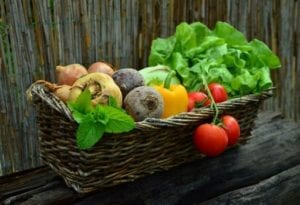Written by Greg Arnold, DC, CSCS. Organic crops are not more nutritious, but have fewer toxic chemicals than commercially farmed crops.
 The definition of growing “organic produce” varies (1, 2, 3) but a uniting principle is the avoidance of synthetic fertilizers and chemical pesticides (4). The last 10 years has seen a 300% increase in the land devoted to organic farming worldwide (37 million hectares among 1.6 million farmers) but this still represents only 0.9% of the total land used to grow produce, with more than 80% found in developing countries (5).
The definition of growing “organic produce” varies (1, 2, 3) but a uniting principle is the avoidance of synthetic fertilizers and chemical pesticides (4). The last 10 years has seen a 300% increase in the land devoted to organic farming worldwide (37 million hectares among 1.6 million farmers) but this still represents only 0.9% of the total land used to grow produce, with more than 80% found in developing countries (5).
The increased demand for organic produce is thought to be due to the fact that organic produce is more nutritious and contains fewer toxic chemical than conventional produce. Now a new report (6) suggests that while the latter is true, the former is not.
Regarding mineral content, the report’s review of the literature suggests it is not organic farming but rather the type of crop, year, place, environment, and harvest timing that “seem to be of higher importance than organic cultivation” (7). For antioxidants, almost no significant differences in carotenoid or tocopherol levels were seen between organic and conventional farming (8, 9). Rather, “environment and genotype seem to play a larger role…than the farming system” (10).
The difference in health benefits seems to lie in pesticide levels as several studies implicate pesticide residues in the development of cancer, Parkinson’s disease, and endocrine related disorder (11, 12, 13). The higher amounts of heavy metals found in conventional versus organic produce (14, 15) in thought to be due to the higher levels of cadmium, copper and zinc in inorganic fertilizers that commonly have been used (16).
For the researchers, “The reasons why organically produced food contributes to public health are unclear” but that “the low amounts of pesticide residues and heavy metals reported in organically produced crops might be one part of the reported basis for an anticancer effect of organic food.”
Source: Johansson, Eva, et al. “Contribution of organically grown crops to human health.” International journal of environmental research and public health 11.4 (2014): 3870-3893.
© 2014 by the authors; licensee MDPI, Basel, Switzerland. Creative Commons Attribution license (http://creativecommons.org/licenses/by/3.0/).
Click here to read the full text study.
Posted July 7, 2014.
References:
- “Food and Agriculture Organization. Organic Agriculture” from the Food and Agriculture Organization website
- International Federation of Organic Agriculture Movements (IFOAM). IFOAM International Federation of Organic Agriculture Annual Report 2007; International Federation of Organic Agriculture Movements: Bonn, Germany, 2007
- United States Department of Agriculture (USDA). Report and Recommendations on Organic Farming; United States Department of Agriculture: Washington, DC, USA, 1980
- Lotter, D. Organic agriculture. J. Sustainable Agr. 2003, 21, 59–128
- Willer, H.; Kilcher, L. The World of Organic Agriculture—Statistics and Emerging Trends 2012; Research Institute of Organic Agriculture (FiBL), International Federation of Organic Agriculture Movements (IFOAM): Bonn, Germany, 2012.
- Johannson E. Contribution of organically grown crops to human health. Int J Environ Res Public Health 2014 Apr 8;11(4):3870-93. doi: 10.3390/ijerph110403870
- Martinez-Ballesta, M.C.; Dominguez-Perles, R.; Moreno, D.A.; Muries, B.; Alcaraz-Lopez, C.; Bastias, E.; Garcia-Viguera, C.; Carvajal, M. Minerals in plant food: Effect of agricultural practices and role in human health: A review. Agron. Sustain. Dev. 2010, 30, 295–309
- Cardoso, P.C.; Tomazini, A.P.B.; Stringheta, P.C.; Ribeiro, S.M.R.; Pinheiro-Sant’Ana, H.M. Vitamin C and carotenoids in organic and conventional fruits grown in Brazil. Food Chem. 2011, 126, 411–416.
- Konopka, I.; Tanska, M.; Faron, A.; Stepien, A.; Wojtkowiak, K. Comparison of the phenolic compounds, carotenoids and tocochromanols content in wheat grain under organic and mineral fertilization regimes. Molecules 2012, 17, 12341–12356
- Smith-Spangler, C.; Brandeau, M.L.; Hunter, G.; Clay Bavinger, J.; Pearson, M.; Echbach, P.J.;Sundaram, V.; Liu, H.; Schirmer, P.; Stave, C.; Olkin, I.; Bravata, D.M. Are organic foods safer or healthier than conventional alternatives? A systematic review. Annal. Int. Med. 2012, 157, 348–366
- Landau-Ossondo, M.; Rabia, N.; Jos-Pelage, J.; Marquet, L.M.; Isidore, Y.; Saint-Aimé, C.; Martin, M.; Irigaray, P.; Belpomme, D. Why pesticides could be a common cause of prostate and breast cancers in the French Carribbean Island, Martinique. An overview on key mechanisms of pesticide—Induced cancer. Biomed. Pharmacother. 2009, 63, 383–395
- Ryan, S.D. Isogenic human iPSC Parkinson’s model shows nitrosative stress-induced dysfunction in MEF2-PGC1 alpha transcription. Cell 2013, 155, 1652–1653.
- McKinlay, R.; Plant, J.A.; Bell, J.N.B.; Voulvoulis, N. Endocrine disrupting pesticides: Implications for risk assessment. Environ. Int. 2008, 34, 168–183
- Zaccone, C.; di Caterina, R.; Rotunno, T.; Quinto, M. Soil-farming system—Food—Health: Effect of conventional and organic fertilizers on heavy metal (Cd, Cr, Cu, Ni, Pb, Zn) content in semolina samples. Soil Till. Res. 2010, 107, 97–105
- Mansour, S.A.; Belal, M.H.; Abou-Arab, A.A.K.; Gad, M.F. Monitoring of pesticides and heavy metals in cucumber fruits produced from different farming systems. Chemosphere 2009, 75, 601–609
- Dos Santos, J.S.; dos Santos, M.L.P.; Contil, M.M. Comparative study of metal contents in Brazilian coffees cultivated by conventional and organic agriculture applying principal component analysis. J. Braz. Chem. Soc. 2010, 21, 1468–1476.
